In issue 490 of White Dwarf, Games Workshop share a new Age of Sigmar battlepack designed for playing 1,000 point games. Cronch is running through the battlepack’s rules and missions here to see how it compares to previous small-game offerings.
Why play 1,000 point games?
As with any popular tabletop wargame, a huge majority of the discussion on Age of Sigmar focuses on matched play, 2,000 point games using the Pitched Battles rules from the most recent General’s Handbook. In reality though, this just isn’t how everybody plays the system; plenty of people want to play smaller games for a wide variety of reasons.
From a time point of view, a full-sized game of AoS can take upwards of 3 hours, especially in a more relaxed gaming environment away from the tournament clocks. By comparison, being able to fit a smaller game into a lunch break or a limited amount of free hobby time at home is a compelling option. It’s also important to acknowledge that not everybody finds it easy to collect a single 2,000 point army – whether that’s for financial reasons, a limited amount of building/painting time, or that hobby butterfly desire to complete a variety of projects rather than repeatedly painting units in the same scheme.
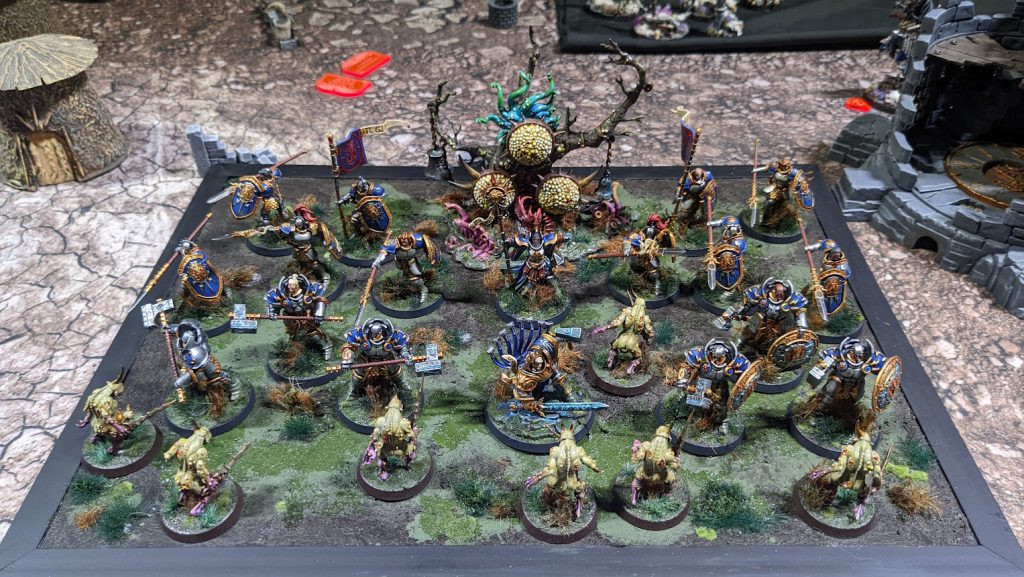
GW’s design studio clearly understand the desire for smaller, faster, more compact games. Even just under the Age of Sigmar product umbrella, Warcry and Warhammer Underworlds offer two popular and well-supported systems for skirmish wargaming. Inside AoS itself, we’ve seen a few attempts across the various releases since its inception. After all, the original AoS core rules suggested that armies could be any size, with no points system at all, and battlepacks continue to contain force requirements and recommended table sizes for various size games. It’s not without its critics, however, with game balance and complexity being regular topics whenever the idea of 1,000 point games is discussed.

It’s hard to talk about small-points Age of Sigmar without somebody mentioning (usually disparagingly) the Meeting Engagements mode from the 2nd-edition General’s Handbook 2019. This used custom battleplans on a smaller (44″ x 30″) board, and included rules on splitting armies into three parts, similar to Warcry’s sword-shield-hammer deployment. These would arrive at different points over the first three battle rounds, in an attempt to keep one force from being overwhelmed too early. I personally enjoyed some casual games of Meeting Engagements, but ultimately it felt a bit too different from regular AoS to gain traction with the community which, alongside the rules vanishing after the next General’s Handbook, meant this mode wasn’t long for this world.
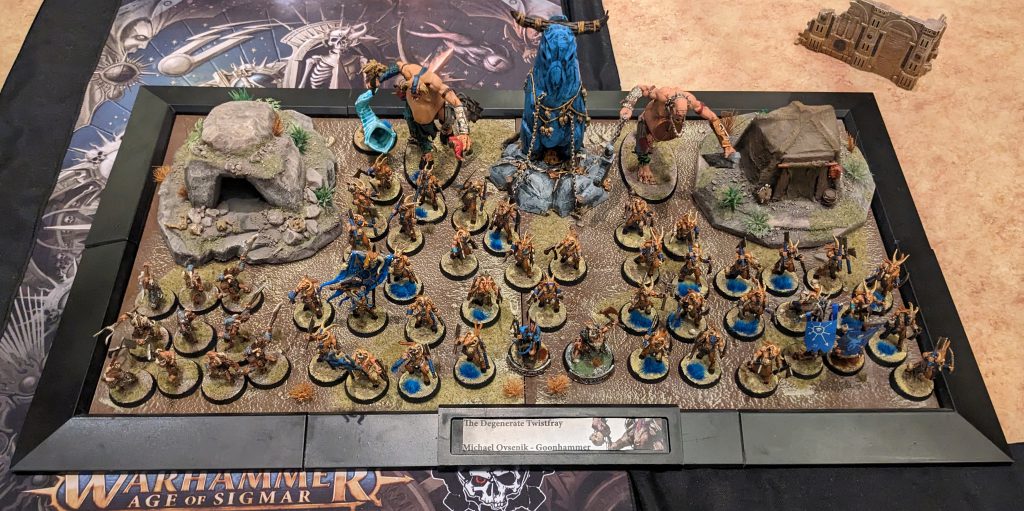
More recently, in February 2023, Steve Wren of the Warhammer World events team shared a prototype offical 1,000 point battlepack on Twitter. Developed by the AoS design team after a 1,000 point Contest of Generals (core book matched play) event, based on their experiences plus feedback from other players at the event, this pack iterates on the Contest of Generals rules with some extra rules (no single unit larger than 350 points, summoned units are half size, inserting the usual Pitched Battles rule of first turn going to the player who finishes deploying first) alongside some tweaked Grand Strategies, Battle Tactics and battleplans. Overall this seemed well-received by the community, and it was great to see a non-standard battlepack getting the kind of care and attention usually reserved for 2,000 point pitched battles.
Battlepack Overview
Which brings us neatly on to the Contest of Warlords battlepack, included in White Dwarf issue 490. Similarly to the Warhammer World pack, this takes the broad list building guidelines from the Contest of Generals/Pitched Battles packs, then adds a couple of extra rules and restrictions. The header claims that the pack was created for White Dwarf’s ever popular Tale of Four Warlords feature, with the aim of being “simple to understand, quick to set up, and as evenly matched as possible”.
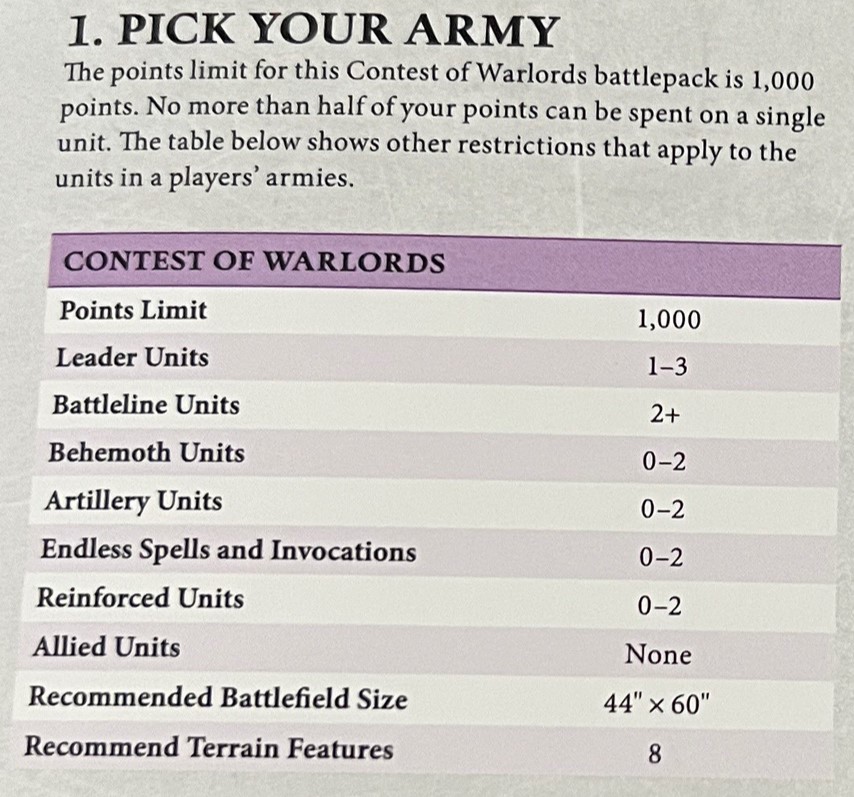
The additional restrictions are as follows:
- No more than half of your points can be spent on a single unit. In practice I expect this is supposed to be “no single unit over 500 points” but it’s feasible to argue that if a list came to 970 points then rules as written the largest unit could only be a maximum of half of that, 485 points. It’s probably not important and if someone were to argue with you on this basis then I fully endorse you telling them to kick rocks.
- Armies must be picked from a single faction, with no allowance for allies. It’s worth noting that other packs have included a specific exemption for coalition units (e.g. Slaves to Darkness in god-keyword armies), whereas here there is no mention of coalition at all. Rules as written, “all of the units in your army must be from a single faction”, so we’d assume coalitions are not allowed. It’s not clear if that’s intentional for reasons of either balance or brevity, or whether it’s an oversight.
- Warscroll Battalions and Core Battalions are both not used in this battlepack. Whilst expected for Warscroll Battalions, now firmly relegated to “these technically exist and maybe one person uses them in their narrative league” territory, the exclusion of Core Battalions is perhaps a touch more surprising. However it’s a rule carried over from the Warhammer World pack, so reasonable to assume that it playtested well, and in my opinion taking away some options for overpowering lists with multiple enhancements or single-drop lists controlling turn order is a good thing at an inherently less-balanced points value.
- Not called out in the rules, but notable by omission: Grand Strategies and Battle Tactics are not in use in this pack, so the points scored on battleplan objectives are the only ones up for grabs.

There are three battleplans included in the pack. We’ll cover them in more detail below, but all three share a few core concepts:
- Players set up on the long board edges, with territories meeting in the middle of the board. Units must be deployed at least 9″ away from enemy territory.
- Players roll off, with the winner choosing to be attacker or defender. The defender then sets up the terrain, followed by the attacker picking their territory. Players then alternate deployment, starting with the attacker.
- A roll off determines priority in the first battle round, with ties won by whichever player finished deploying first.
- Battles last for 5 battle rounds.
- The player with the most victory points at the end of the battle wins a major victory. In the event of a tie, the player who destroyed the most enemy units wins a minor victory. If that’s a tie too, the game is a draw.
Onto the battleplans!
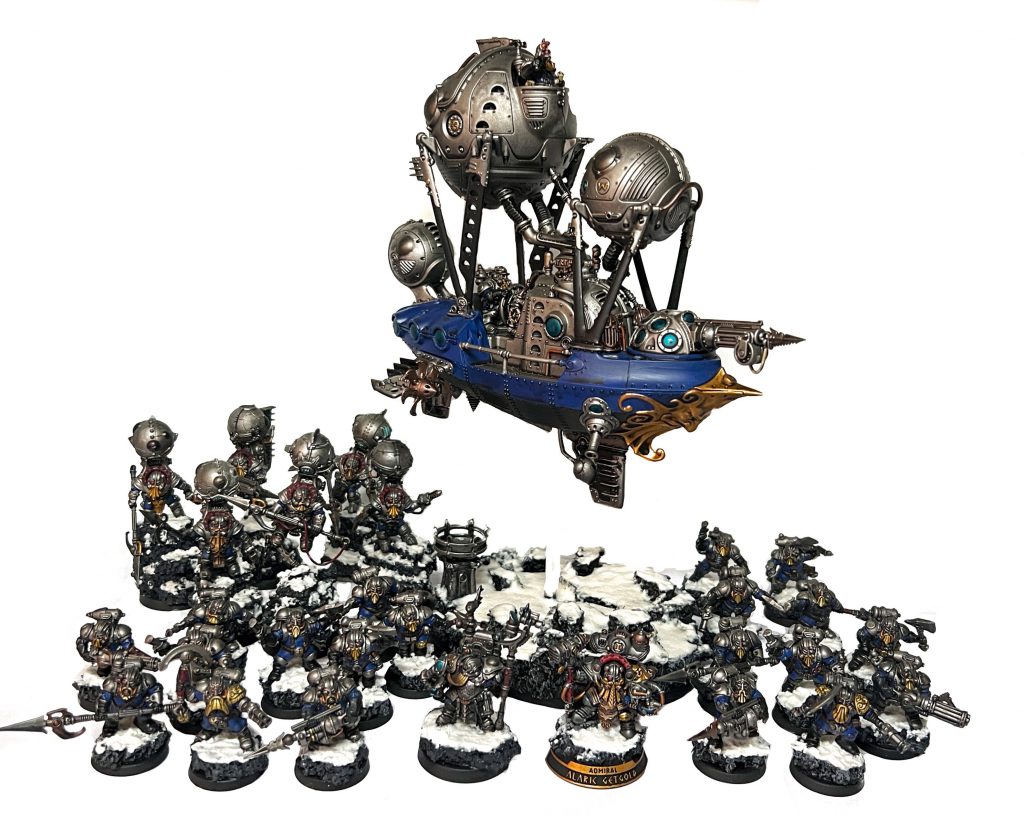
Battleplan 1 – Seismic Shift
Repurposing a realm rule from the General’s Handbook 2021, Seismic Shift sees objectives disappearing from the board, meaning generals will need to plan for flexibility and be ready to change plans at short notice.
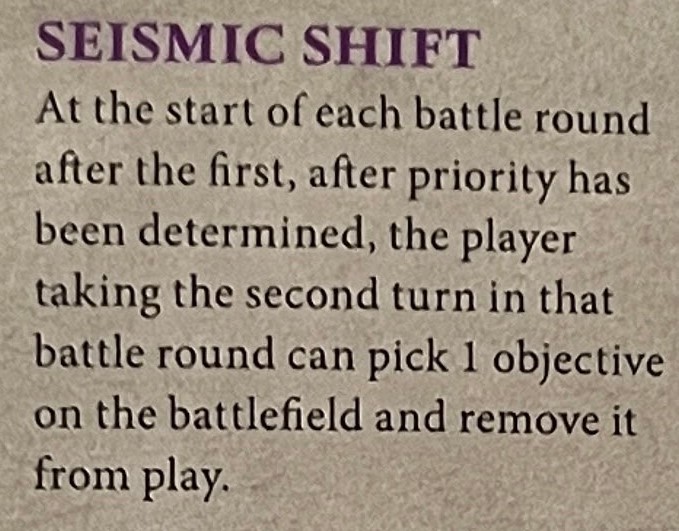
With objectives in the centre of the board and the centre of each table quarter, careful movement and planning will be important here, especially given the smaller number of units on the table at 1,000 points. Scoring follows a standard “hold one, hold two, hold more” progression, for a maximum of three points per turn. There’s no reward for the second player removing an objective, other than disrupting their opponent’s plans, but it should lead to some tense dashes across the board in later battle rounds.

Battleplan 2 – Border War
Border war is a classic battleplan, with versions dating back to the very first General’s Handbook in 2017. Players score points per objective they control: one point for the objective in their territory, two points per border objective, and four points for the one in the enemy’s territory.

This points escalation encourages pushing forward into enemy territory and punishes armies that like to sit back and shoot. It’s quite common for variations on this battleplan to become a kind of grand melee around the two central objectives, and in this instance the design have added an extra rule called Pillars of Victory to incentive against this. At the start of each battle round, players can claim an extra command point for each table quarter that contains a friendly Battleline unit. Ultimately all the command points in the world aren’t a compelling alternative to just being on the objectives and scoring points, but it might encourage players to spread their units a bit more tactically and get to use some extra command abilities in return.
Battleplan 3 – Changing Priorities
Another battleplan that’s appeared in various similar forms across battlepacks, Changing Priorities features 3 objectives across the centre line of the board, with one becoming the primary objective at the start of each battle round. Scoring is similar to Seismic Shift: one point for controlling at least one objective, one for controlling two or more, and a final point for controlling the primary objective.
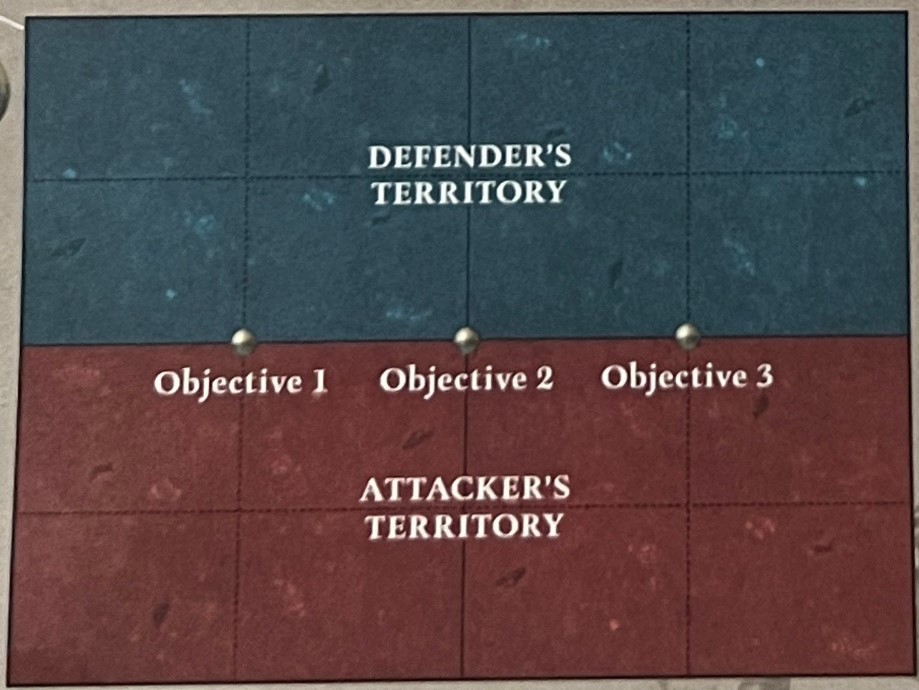
As implied by the battleplan name, this random shifting can lead to priorities changing across the game, often quite frantically. There’s no hiding that it can be quite annoying to have the primary objective shift at the wrong time and destroy your strategy, but in my experience scenarios like this normally lead to a fun game with the potential for last-minute comebacks.
Impressions and Final Thoughts
Overall, Contest of Warlords feels like a tight, compact battlepack for playing smaller, quicker games of Age of Sigmar. There are a couple of surprising choices, such as the lack of coalition forces, which might grate for players who like to build thematic armies and have absolute clarity. This is forgivable for a free pack-in with White Dwarf, although that does mean that it’s unlikely to be updated or FAQ’d in the future. Ultimately, that’s the primary concern with this battlepack; will it gain traction as a different way of playing the game, or fade into obscurity and irrelevance like so many before it?
That concern aside, it’s likely that we’ll continue to see Games Workshop experimenting with new ways of playing smaller games. It wouldn’t be particularly surprising if in 12-18 months’ time we’re talking about AoS 4’s “Vanguard” mode, a la 40k’s Combat Patrol. In the meantime, I’d be perfectly happy playing casual games at 1,000 points using the Contest of Warlords pack, and it provides a nice framework for running an easy RTT at a local games store to boot. Limited battleplan selection may hinder long term replayability, but it’s a solid template for some casual fun with smaller armies.
Do you have any thoughts on the Contest of Warlords battlepack, or 1,000 point games of Age of Sigmar in general? Comment below, or email us at contact@goonhammer.com!
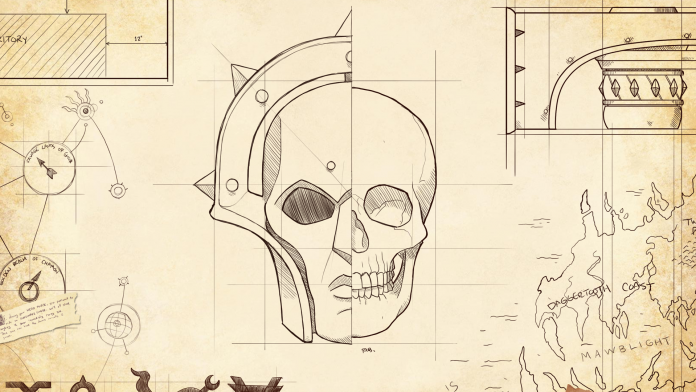


You must be logged in to post a comment.